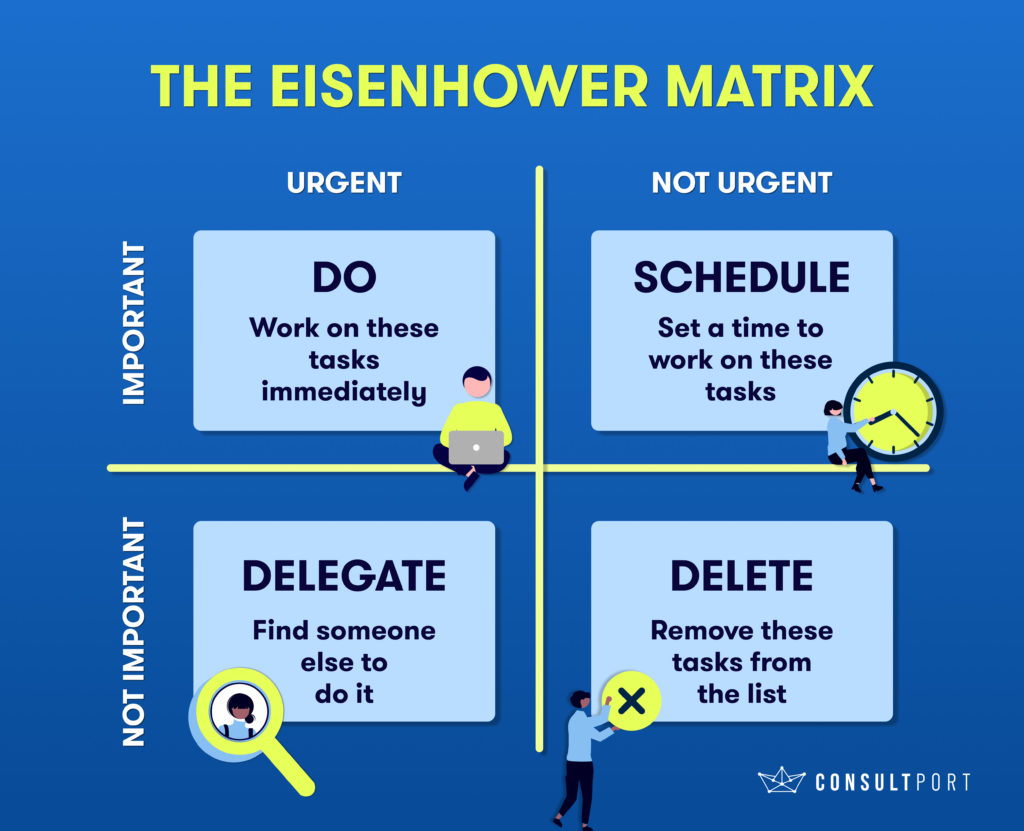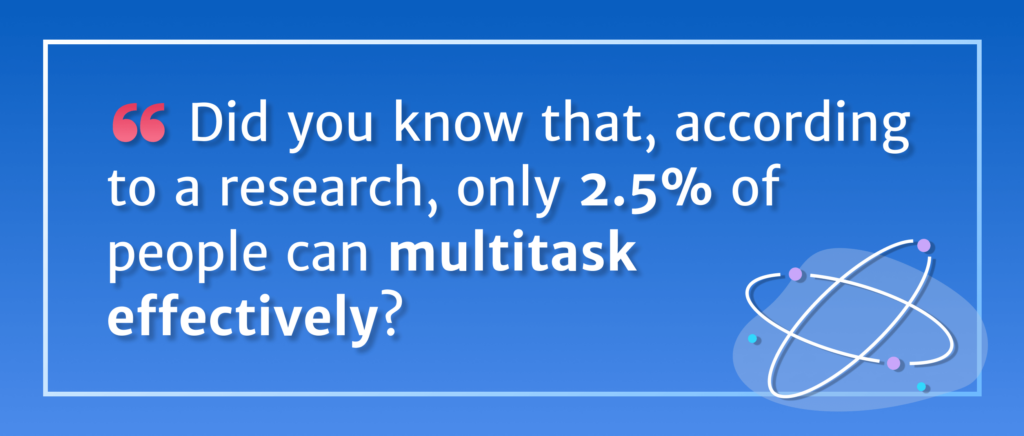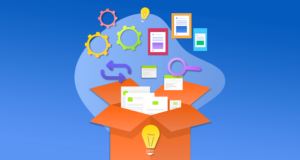7 Tools & Techniques to Beat Procrastination and Boost Productivity
Blog Categories:
Published:
January 16, 2024
Reading Time:
6 minutes

Have you ever felt like you're not as productive as you could be? Well, don’t worry, we’ve all been there at some point. Sometimes, things just don’t work out.
Picture this: you're working on a project, surrounded by tasks that seem insurmountable. The sheer scale of the workload can be overwhelming, which then leads to a sense of stagnation and frustration. In those moments, the struggle to initiate work, manage time effectively, and combat procrastination becomes all too familiar.
In this article, we’ll discuss practical strategies derived from productivity experts to transform your work habits and conquer each task with high efficiency.
So, let’s dive into it.
Picture this: you're working on a project, surrounded by tasks that seem insurmountable. The sheer scale of the workload can be overwhelming, which then leads to a sense of stagnation and frustration. In those moments, the struggle to initiate work, manage time effectively, and combat procrastination becomes all too familiar.
In this article, we’ll discuss practical strategies derived from productivity experts to transform your work habits and conquer each task with high efficiency.
So, let’s dive into it.
KEY TAKEAWAYS
- By using the two-minute rule, you can break down tasks into two-minute increments to overcome resistance, build momentum, and prevent procrastination.
- The Eisenhower Matrix helps you prioritize tasks based on importance and urgency.
- Through the 80/20 rule (Pareto principle), you can identify and prioritize high-impact tasks (top 20%) for efficient time and resource allocation.
- Kanban boards help you utilize visual boards to manage workflow stages, aiding team collaboration and task completion.
1. Use the Two-Minute Rule
This rule, popularized by author David Allen in the book Getting Things Done, states that if you can finish a task in two minutes or less, complete it right then and there.
You see, tackling smaller portions helps you overcome the initial resistance to start. As a result, this makes it easier to build momentum and ward off procrastination. Furthermore, if there are unrelated smaller tasks that are distracting you from the bigger goal, get them done first.
Here are some ways to do it practically:
This tool can help you measure the importance and urgency of tasks. As you can see in the image, the Eisenhower Matrix is divided into four quadrants.

The Pomodoro technique is simple yet effective. Basically, it involves short, focused intervals of work followed by a small break—and repeat. This approach optimizes your attention span and makes it easier to stay on task and resist the urge to procrastinate. Here’s a practical way to do it:

The word kanban means “visual signal” in the Japanese language. Kanban boards like Trello and Asana are widely popular among productivity gurus—and rightfully so. These boards typically consist of several key categories or columns that represent different stages of a workflow. Here are some common categories:
Examples of high-value (top 20%) tasks

You see, tackling smaller portions helps you overcome the initial resistance to start. As a result, this makes it easier to build momentum and ward off procrastination. Furthermore, if there are unrelated smaller tasks that are distracting you from the bigger goal, get them done first.
Here are some ways to do it practically:
- Work on incremental progress: Break down large tasks into bite-sized components for incremental progress.
- Make efficient decisions: Apply the two-minute rule to streamline decision-making and prevent tasks from piling up.
- Be proactive: Proactively handle quick tasks to prevent them from accumulating and becoming overwhelming.
- Boost your morale: Immediate completion of short tasks contributes to a sense of achievement, propelling you toward larger goals.
2. Follow the Eisenhower Matrix

This tool can help you measure the importance and urgency of tasks. As you can see in the image, the Eisenhower Matrix is divided into four quadrants.
- The Important/Urgent tasks, for example, crises and deadlines, need immediate attention.
- Important/Not Urgent tasks, such as exercise and side projects, can be planned for a later date.
- Unimportant/Urgent tasks take a backseat and can be delegated—think interruptions and meetings.
- Lastly, Unimportant/Not Urgent tasks gracefully exit the stage, leaving space for more impactful endeavors.
3. Give the Pomodoro Technique a Try

The Pomodoro technique is simple yet effective. Basically, it involves short, focused intervals of work followed by a small break—and repeat. This approach optimizes your attention span and makes it easier to stay on task and resist the urge to procrastinate. Here’s a practical way to do it:
- Step 1: Choose a big task
- Step 2: Set a timer for 25 minutes
- Step 3: Work till the timer starts beeping
- Step 4: Take a 5-minute break
4. Try Kanban Boards

The word kanban means “visual signal” in the Japanese language. Kanban boards like Trello and Asana are widely popular among productivity gurus—and rightfully so. These boards typically consist of several key categories or columns that represent different stages of a workflow. Here are some common categories:
- To-do: Initial stage where tasks are collected and await action.
- In progress: Active tasks currently being worked on by team members.
- Review: Completed tasks undergo evaluation and quality assurance.
- Done: Final destination for successfully finished tasks.
- Blocked: Tasks facing obstacles or issues preventing progress.
- Backlog: Holding area for future tasks or ideas not yet scheduled.
- Priority: Dedicated column for high-priority or urgent tasks.
- Doing: A distinction between actively in-progress tasks and those under review or validation.
5. Leverage the 80/20 Rule (Pareto Principle)
This principle states that roughly 80% of effects come from 20% of causes. When applied to task management, it encourages a strategic approach to prioritize efforts based on their impact. And in a world where time is a valuable commodity, the 80/20 Rule serves as a compass for efficiency. You see, some tasks are more important than others. These could be specific projects, clients, or types of work. Once identified, channel a disproportionate amount of your efforts and resources toward these high-impact areas. Let’s consider some examples.Examples of high-value (top 20%) tasks
- Client acquisition and retention: There’s no business without clients and customers. So this task definitely comes in the top 20%.
- Strategic planning: Invest time in outlining long-term goals, developing strategies, and creating action plans that align efforts with overarching objectives.
- Priority projects: Focus on tasks associated with critical projects or initiatives that significantly contribute to organizational success.
- Innovation and creativity: You should give attention to tasks that foster innovation, creativity, and the development of new ideas that can lead to breakthroughs and market differentiation.
6. Improve Focus With Time Blocking
Did you know that according to research, only of people can multitask effectively? So, it’s highly likely that you’re one of those individuals who can only work on one task at a time—and that’s fine. Now, to improve focus on a single task, you could use time blocking to give full attention to one task at a time. Here’s how to do it like a pro:- Identify priorities: Begin by pinpointing the most crucial tasks aligning with your goals and responsibilities.
- Categorize and allocate: Group similar tasks and assign specific time slots to create a structured schedule.
- Protect your blocks: Treat designated time blocks as non-negotiable appointments. You must minimize disruptions for focused work.
- Regular review and adjustment: Periodically assess your time-blocking strategy and make adjustments based on changing priorities or workflow dynamics.
- Reflect and celebrate: Conclude each day with a brief reflection on achievements and challenges, and refine your approach for greater effectiveness.

7. Set Goals With the Rapid Planning Method (RPM)
The Rapid Planning Method (RPM), pioneered by the world’s leading performance coach Tony Robbins, introduces an outcome-focused approach to planning and productivity. Unlike traditional task-centric methods, RPM focuses on defining the desired results and purpose behind each action. The idea is to align every task with overall outcomes.
For example, if you're a freelance consultant working on data analysis, the Rapid Planning Method (RPM) shifts the focus from a mere checklist of analytical tasks to an outcomes-driven approach. This ensures that you don’t just think about tasks like executing focus groups and surveys to collect data—instead, you’ll consider how your client will dominate the market with your help.
Here’s a simple way to implement RPM in your projects:
Talking about consultants, here at Consultport, we’re on a mission to connect top-tier consultants with clients from all around the world. We have over 10,000 consultants in our talent pool and all of them have one thing in common—they’ve worked with top consulting firms, digital agencies, or blue-chip companies.
So, if you think you fit the profile and are ready to take on high-paying and exciting freelance projects, get in touch with us now.
For example, if you're a freelance consultant working on data analysis, the Rapid Planning Method (RPM) shifts the focus from a mere checklist of analytical tasks to an outcomes-driven approach. This ensures that you don’t just think about tasks like executing focus groups and surveys to collect data—instead, you’ll consider how your client will dominate the market with your help.
Here’s a simple way to implement RPM in your projects:
- Define outcomes: Clearly outline the specific outcomes or goals you want to achieve.
- Add tasks to groups: Organize tasks into logical groups aligned with each outcome.
- Prioritize impact: Prioritize tasks based on their impact on achieving desired outcomes.
- Assess progress: Regularly evaluate progress and adjust tasks for optimal results.
- Execute effectively: Approach tasks with a clear understanding of their contribution to overall goals.
Talking about consultants, here at Consultport, we’re on a mission to connect top-tier consultants with clients from all around the world. We have over 10,000 consultants in our talent pool and all of them have one thing in common—they’ve worked with top consulting firms, digital agencies, or blue-chip companies.
So, if you think you fit the profile and are ready to take on high-paying and exciting freelance projects, get in touch with us now.
Share This Story, Choose Your Platform!



